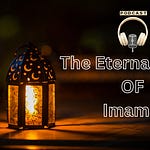Bismillahir Rahmanir Rahim.
Welcome to this episode of Timeless Light, where we explore spiritual concepts, historical truths, and the timeless journey of the soul. Today, we’ll discuss the profound concept of Imamat and its eternal nature—a light that has illuminated the world across all eras.
Before we dive deeper, let’s take a moment to reflect on the idea of time. Time has no beginning and no end—it flows in a continuous circle. Imamat, too, shares this timeless quality. It has no starting point or endpoint. It is eternal, existing since the beginning of creation and continuing forever.
But this raises an important question: If Imamat is eternal, how can Hazrat Ali (Allaihi Sallam) be called the first Imam?
The answer lies in understanding that even during the era of Prophethood, Imamat existed. However, it was present in a hidden, spiritual form. At times, it resided within prophets and messengers, and at other times, it existed separately. This spiritual presence became manifest after the Prophethood of the Holy Prophet Muhammad (Peace be upon him and his progeny).
Hazrat Ali (Allaihi Sallam) is regarded as the first Imam because it was through him that this noor, or light, became visibly manifest in the world after Prophethood.
Imamat, like Prophethood, is a noor. This noor is eternal—it has no beginning and no end. When the noor takes a physical form, it follows the natural laws of the world: birth and death. But the essence of the noor remains the same; only its outward appearance changes.
The eternal nature of this noor is beautifully explained in the teachings of Hazarat Imam Sultan Muhammad Shah (Allaihi Sallam) and in Surah 24:35 of the Holy Quran:
"Allah is the Light of the heavens and the earth. His light is like a niche in which there is a lamp, the lamp is in a crystal, the crystal is like a shining star, lit from ˹the oil of˺ a blessed olive tree, ˹located˺ neither to the east nor the west, whose oil would almost glow, even without being touched by fire. Light upon light! Allah guides whoever He wills to His light. And Allah sets forth parables for humanity. For Allah has ˹perfect˺ knowledge of all things."
Surah An-Nur - 35
This verse describes Allah as the Light of the heavens and the earth, using the metaphor of a lamp.
The noor of Imamat is not bound by time or place. It is timeless and transcendent. It operates across different dimensions, just like the olive tree mentioned in the Quran—its many branches representing the various levels at which Imamat functions.
This noor, like a lamp, enlightens the mind and soul with its radiance. Without this divine light, how could someone like me, with no significant knowledge, find the words to share these reflections with you? This is the grace of the noor, which illuminates the world for those who seek knowledge and purity of heart.
Throughout history, people have tried to suppress this noor, as they did with Prophethood and Imamat. Even today, there are those who speak against Shah Karim Haazar Imaam. This opposition is itself evidence that this noor has always existed in physical form.
Surah As-Saf (61:8) highlights the futile attempts of those who oppose Allah’s light and truth. The verse reads:
"They want to extinguish the light of Allah with their mouths, but Allah will perfect His light, even though the disbelievers dislike it."
As-Saf (61:8)
This verse metaphorically illustrates the divine guidance and truth as Allah's light (Noor). It emphasizes that despite the efforts of detractors to suppress or deny this truth through propaganda, slander, or active opposition, their attempts are destined to fail. Allah's light, representing His guidance, will continue to shine and reach its fullness, unaffected by human resistance or disbelief.
This concept resonates deeply with the idea of Imamat and Prophethood as carriers of divine Noor. Throughout history, individuals and groups have tried to challenge or suppress this Noor. Yet, as promised in this verse, Allah safeguards it, ensuring its continuation and ultimate triumph. This assurance offers hope and reassurance to believers that truth and guidance are protected by divine will.
As we delve deeper into the concept of Imamat, we see how it operates at different levels. Sometimes, the Imam manifests directly, while at other times, he works through his representatives, the Pirs and Dais, to guide his spiritual children. A beautiful example is how Dai al-Mu'ayyad (Rahmatullah Alayhi) enlightened Pir Nasir Khusraw (Rahmatullah Alayhi).
In the next episode, we’ll focus on the role of the Pir—how they nurture our spiritual growth. Just as a mother endures pain to give birth to a child, the Pir works tirelessly to guide us on the spiritual path.
Life is a circle of time, where joy and sorrow alternate. Often, people question the Imam during hardships. Yet, these challenges are an essential part of life. When we recognize these difficulties as blessings and awaken the love of the Imam in our hearts, the Imam blesses us with the guidance of his spiritual representative, the Pir.
Let us reflect on the eternal nature of Imamat and how it continues to guide, illuminate, and nurture us, generation after generation.
Thank you for joining me today on Timeless Light. Don’t forget to tune in to the next episode, where we’ll explore the profound role of the Pir in our spiritual journey. Happy New Year & Yaa Ali Madad.












